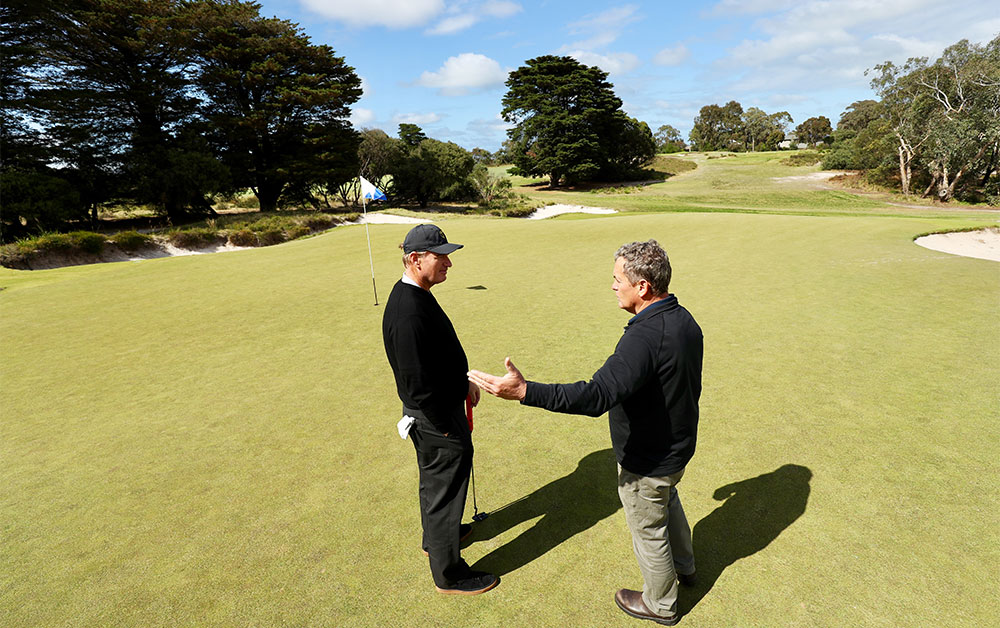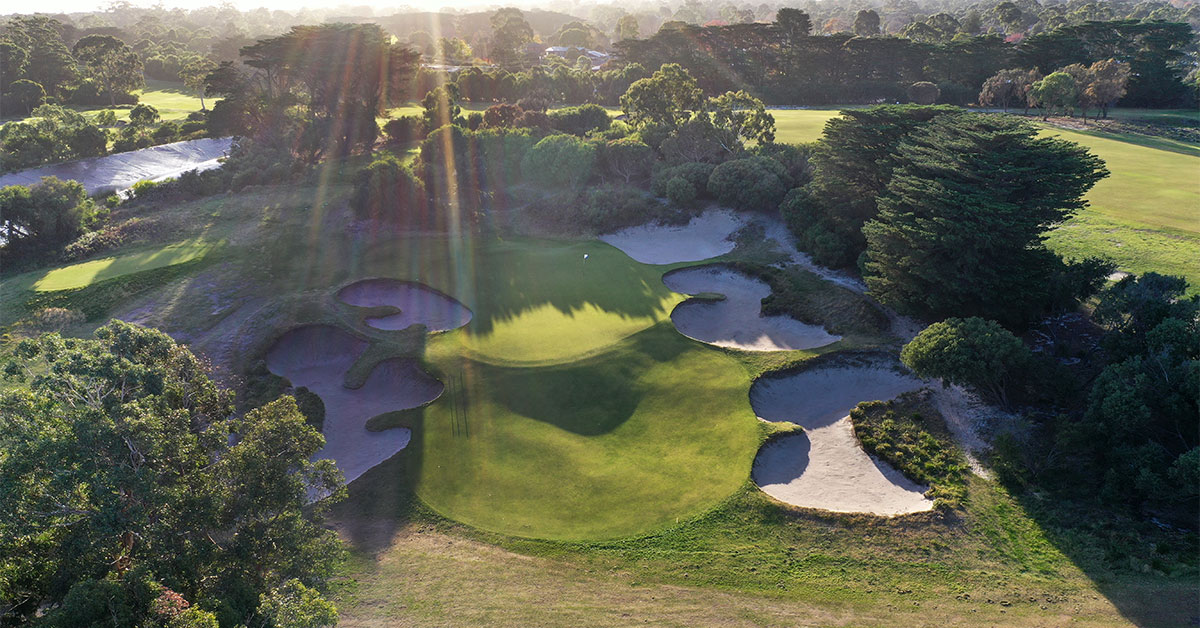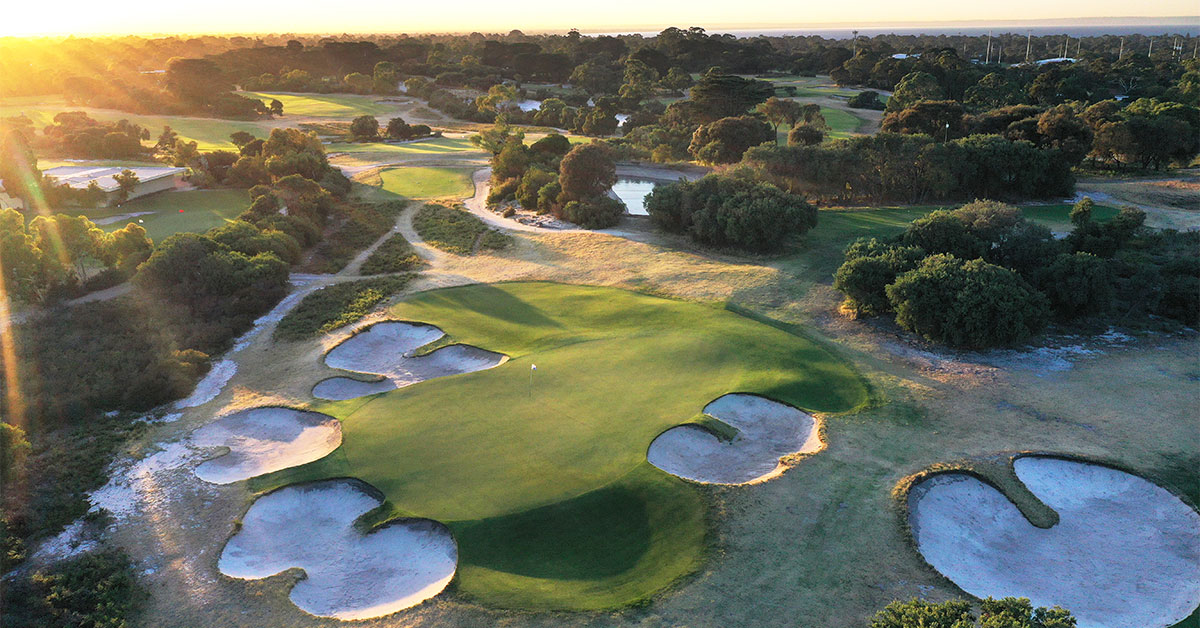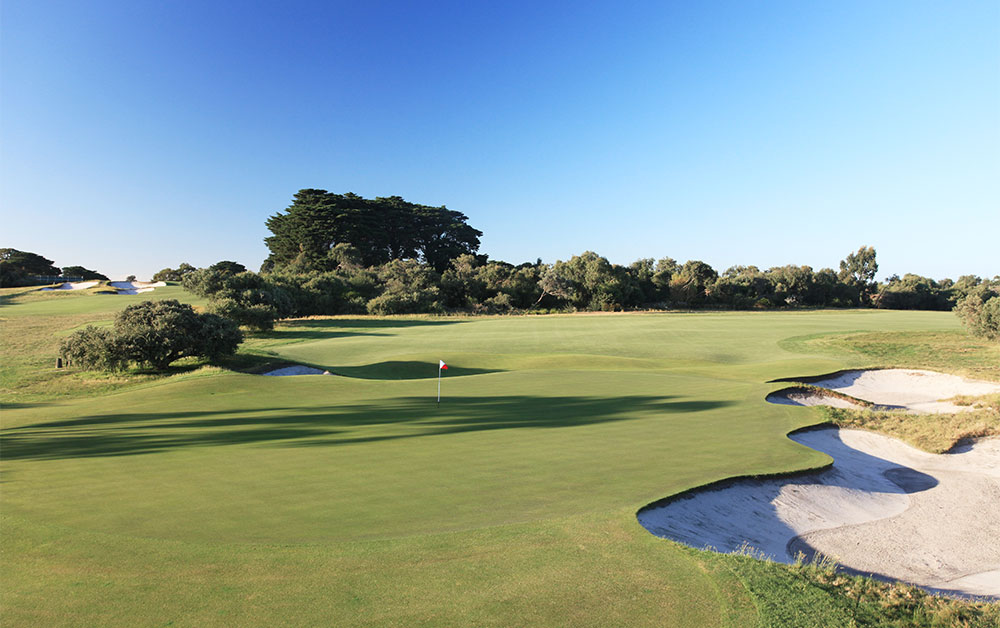Course Photography by Gary Lisbon
When players arrive at Royal Melbourne Golf Club on December 9, they will notice one significant change in an attempt to rein in the length running rampant on tour.
“We’ve had to extend the netting at the end of the practice range,” explains Royal Melbourne general manager Warwick Hill-Rennie. “Because they hit it so far, they’ll hit it over the top of the net.
“We asked for trajectory testing because we wanted to know when Dustin Johnson or Brooks Koepka were hitting drivers how high we needed to go. It is 275 metres to the net and their drives are still 20 metres in the air at that point. It’s a different game.”
But how will that power transfer to a Composite course that will measure 6,449 metres for the 2019 Presidents Cup and remains one of the most treasured pieces of golf architecture anywhere on the planet?
“We’ve been hosting the Master of the Amateurs each year for the past eight years and you can see the next generation PGA Tour professionals playing there,” says Royal Melbourne director of courses Richard Forsyth, who joined Royal Melbourne six months before the 2011 Presidents Cup. “Those young guys look at the yardage book and want to fly it straight to the hole, but if you do that on a lot of holes you’ll end up in a pretty nasty spot.
“It’s going to be a little bit weather-related in terms of how much bounciness we can get in the greens, but the tradition at Royal Melbourne is to have that firmness. As far as they hit it down the fairway, you can still see some of the strategy come into play by having the firmness in the green.”
A member of three Presidents Cups for the Internationals, Australian legend Craig Parry has no doubt that whatever length big hitters possess, it is diminished somewhat by the nature of how Royal Melbourne can play.
“Long hitters have an advantage at every golf course because they’re hitting short irons into the green,” Parry tells Australian Golf Digest. “However, at Royal Melbourne you want to make sure that you hit it the correct distance off the tee with the correct line into the green. That way you leave the right yardage for your approach shot and the right angle from which to approach the hole location. If you hit it in the wrong location off the tee, it’s extremely difficult to hit the second shot close on a par 4 or to even make a par at a par 3 if you hit it in the wrong spot on the green.”

Bounce Of The Ball
Balance is often an elusive goal at a course such as Royal Melbourne. For the best shots to receive the greatest reward, the perilous putting surfaces must be presented in such a way that poorly executed shots into the greens not only make par a challenge but bring double-bogey into play.
Over the course of its storied history, Royal Melbourne’s challenge has brought the best players to the fore: Aussie greats Greg Norman, Norman von Nida, Jim Ferrier, Graham Marsh, Adam Scott and Jason Day all victors along with international legends such as Gary Player, Seve Ballesteros, Tom Watson, Hale Irwin and three-time Heineken Classic champion and course-record holder Ernie Els.

The PGA Tour would prefer holes were won with crowd-rousing birdies rather than conceded by a three-putt bogey, but Forsyth hopes he and his staff will be allowed to arm ‘Royal’ with close to the entirety of its natural defences.
“Ernie has said that he wants to see it play as it traditionally does, so that’s good for us but the tour wants to see birdies and the like to win holes,” Forsyth explains. “There’s a balance between the two, but we’ll certainly be aiming to have the firmness of the greens as close to the traditional way that we have them as we can.
Ernie has said that he wants to see it play as it traditionally does, so that’s good for us but the tour wants to see birdies and the like to win holes.
– Richard Forsyth
“There was a perception that we may have had it a little too firm and fast on the Friday of the last event (in 2011). They would like to see a ceiling on the green speed, but for the members, they always want to see it presented firm and fast and test them out. For those guys it’s very hard to get greens firm enough where they’re not getting some purchase on it, but the greens here can get like that. If it’s not too hot and it’s dry leading in, then you can get quite bouncy greens without having to do anything. We’d all love to see it really reward the guy that hits the premium, best shot.”
Woods, serving as playing captain and one of four US survivors from the team that was victorious at Royal Melbourne in 2011, remembers clearly the state of the greens on the opening two days of the matches eight years ago.

“It was quick the first day. The greens looked kind of blue,” Woods recalls. “Putters were slipping on greens, the balls were oscillating on the greens. I mean, it was quick. The guys who did play, whether it’s Webby, me, Dustin, we saw it. It was pretty amazing to see.
“I thought it was just an amazing experience, to play something that quick, that fast and that tricky where you really had to think all the way around. You have a sand wedge in your hand and you can’t fire at a flag. You have to fire 15 or 20 feet away because honestly you can’t get it close. And that’s where it’s going to be fun for us to go down there and play that type of golf. It’s unique. It’s very different. It’s a combination of playing links golf and Augusta National all in one.”
“It’s unique. It’s very different. It’s a combination of playing links golf and Augusta National all in one.”
– Tiger Woods
Few know that better than the man at the helm of an International team trying to break a 21-year losing streak at the scene of their only triumph. It’s been 15 years since Els shot 60 in the opening round of what would be his third straight Heineken Classic triumph at Royal Melbourne, and the South African intends to flood his players with information as to how best to tame the Melbourne Sandbelt matriarch.

“I’ve got all kinds of different plans to show them how each and every hole should be played,” Els reveals. “The tour staff will set up the golf course and also the flag positions, but I’ve got a lot of experience around Royal Melbourne, of the winds and certain conditions.
“In the practice rounds I will make it my mission to let every single player know of where to be hitting it and definitely where the ‘Xs’ are – where you do not want to go. I’ll be going through their notebooks myself personally and putting in notes and do as much as I can to help these guys understand the course, the conditions, the winds and so forth. There could be a lot of work that I have to do on that front because it can be quite a tricky course with certain flag positions and winds.”
“In the practice rounds I will make it my mission to let every single player know of where to be hitting it.”
– Ernie Els
Although a Presidents Cup debutant in 2019, American Bryson DeChambeau is no stranger to Royal Melbourne and the Melbourne Sandbelt. Runner-up to Peter Senior while still an amateur at the 2015 Australian Masters at Huntingdale, DeChambeau had earlier that year finished tied for third behind Zach Murray at the 2015 Master of the Amateurs, Royal Melbourne leaving a lasting impression.
“That is truly one of my favourite golf courses in the world, it being a MacKenzie design,” said DeChambeau, his unique shot analysis sure to be tested by Melbourne’s often-fickle weather.
“The keys around that track are going to be iron play. Certainly it’s a position golf course. The ball can run out quite a bit and playing into the right part of the green from the right angle is very key. You have to have great ball-striking capabilities to be able to work it both ways and control your ball and control the spin around the greens, as well. That’s personally what I think you need to do well in order to succeed out there and why I played really well when I went down there.”
 Weather Dependent
Weather Dependent
The first day of Presidents Cup competition held outside the United States tells you everything you need to know about golf in Melbourne and the impact of weather. On the opening day of the 1998 matches the temperature in Melbourne reached 38 degrees. Cameramen were collapsing, their equipment imploding. In an event that was to be broadcast to the world, it was a challenge to get any vision beyond Black Rock.
“The weather was a composite as well, a medley of three seasons – spring, autumn and purgatory,” John Garrity wrote for Sports Illustrated. “Last Friday’s matches were played in the worst December heat Melbourne has seen this century, a toasty 108 (Fahrenheit) with hair-dryer winds. Saturday afternoon brought cooler south-westerly breezes and a whiff of Port Phillip Bay. Then on Sunday came cloudbursts and chill, giving the players and their wives a chance to show off their whole wardrobes.”
“I don’t want to give away too much, but a weather forecast tells you a lot about what you’re going to get at Royal Melbourne on any particular day and how to play the course,” offers Craig Parry, who famously chipped in to defeat Tiger Woods and Fred Couples on the Saturday in ’98 and won all three Presidents Cup singles matches he played.
“You have to be really aware of what the weather forecast is. Driving to the golf course, I always used to drive by the bay because if it was windy at the bay it was going to be windy at the golf course. Wind direction is something that you have to be acutely aware of because the holes at Royal Melbourne go in all different directions. It’s probably the most weather-affected course there is in terms of strategy. It’s up high on the hill so wind from any direction will affect the golf course. And you have to know where your points on the compass are from the tee, which is something that American players tend to struggle with when they come down here.”
“The wind plays such a major factor in how the golf course is played,” Woods concedes. “If you get the northerlies coming in there and it gets hard and fast and it’s hot, that place is one of the trickiest golf courses you’ll ever play.”
Bombs away!

Six Figures!
At Royal Melbourne design genius comes in all sizes.
1st – par 4, 341 metres
Design connoisseurs might want to turn away as certain players approach the first green (3 West) during this Presidents Cup, for it’s possible the likes of Brooks Koepka and Dustin Johnson will find themselves with sidehill, or even uphill, chips for their second shot. One of the most remarkable front-to-back targets built during the Golden Age of golf architecture (pre-World War II), the second shot here has always challenged the golfer to hit firmly enough to cross or carry the swale in front of the green, but not too hard as to shoot through the back. Bombers driving through the fairway and chipping from near the next tee will make plenty of observers uncomfortable, but fail to lessen the charm of this brilliant short par 4.

3rd – par 3, 161 metres
The third (5 West) was the only hole at Royal Melbourne built under the direct supervision of designer Dr Alister MacKenzie. That he had confidence in Mick Morcom to finish construction after he left, and later described him as the best superintendent he had come across, will not surprise those who have stood on this tee and marvelled at its green complex. Played across a deceptive valley, the putting surface leans aggressively to the front and with deep bunkers cut into both sides. You can’t miss left or right here, nor can you leave your tee shot short of the green or past the pin. Repeatedly across Royal Melbourne, the margins are incredibly fine.
4th – par 4, 401 metres
Royal Melbourne’s famous fourth (6 West) is probably the best dogleg par 4 in Australia. Although somewhat diminished by the ease with which leading professionals can carry its angled drive bunkers, the approach remains as fearsome as anything at Augusta National, principally because hitting past the pin and coming up short are both disastrous. Course superintendent Richard Forsyth describes this green as having the “toughest two-putt” on the course. Its back bunker is also the hardest to get up and down from anywhere on the Sandbelt. The bank behind the green is perfect for those wanting to park themselves in one spot and witness both incredible shot-making, as well as extreme disappointment.

5th – par 3, 135 metres
There isn’t a golf course with more beautifully bunkered par 3s than Royal Melbourne’s Composite course, and the fifth (7 West) is not only the shortest hole, it’s also one of the nastiest. Even the best bunker players in the world struggle to make par from the sand here, so playing safely to the left is often a smart move. The problem for professionals is that most are conditioned to fire at pins with their wedges, which is rarely a sound strategy on this hole.
6th – par 4, 285 metres
Famous for the enormous bunker that its fairway bends around, this driveable par 4 (10 West) features a tricky green site that mere mortals are best advised to approach with a full wedge in hand. With some of the longer hitters at the Presidents Cup likely to be tempted to go for the green off the tee, spectators should see everything from eagles to conceded holes here.
15th – par 5, 520 metres
Despite being the longest hole on the Composite course, the 15th (17 East) will still play like a par 4 for many of the competitors, as much because of the huge technological advancements made in the game as for the downhill nature of its tee shot. Regardless of par, the Alex Russell-designed green site and diagonal bunkering through the final 80 to 90 metres give the hole great beauty, and make it perfect for matchplay.
– Darius Oliver
For more information on a Golfing Great head to Visit Victoria.




